The legislation sets the rules road traffic that are binding. Among them, a group of signs stands out that prohibit passage or entry in certain places.
Each driver should understand what they mean, who they apply to, whether there are exceptions, and what punishment will follow for breaking them.
One of the most significant in traffic rules is the sign "No traffic"... To avoid unpleasant situations, it is necessary to understand not only the scope of its application, but also what kind of fine for travel under the sign "No traffic" awaits each violator.
Compliance with the rules will allow you to avoid a huge number of various complications with law enforcement agencies.
The sign "No traffic" belongs to the group of prohibiting signs... They mark those sections of the road and territories on which movement is prohibited for any vehicles.
It differs from the No Entry Sign in that it is never placed on a one-way road section before a turn. This must be distinguished, since many people confuse the meanings of similar signs.
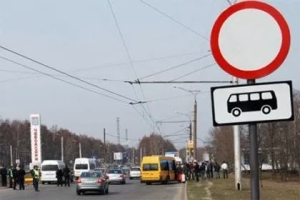
This sign has a round shape in white with a red border around the perimeter. The sign restricts movement in both directions, both in oncoming traffic and on the way.
In most cases, the "No traffic" sign is installed in the following cases:
- In order to indicate to drivers that there is a pedestrian zone on this section of the road. Most often, when the street is blocked on the occasion of some festive event.
- In case of damage to the roadway due to repair robots.
- Sometimes it is installed together with the "Dead End" sign at the entrance to the courtyards.
- Before the entrances to the closed areas of enterprises.
Quite often, sign 3.2 - "No traffic" is installed together with signs showing arrows pointing to the right, left or in both directions.
They indicate the direction in which the sign is valid. For example, movement to the left may be prohibited on weekdays, and movement in both directions on holidays and weekends.
There are some categories that are not covered by the sign. Entry under the sign "No traffic" can be carried out by:
About other automobile means in the SDA nothing is said. This means that the action of the prohibiting sign applies to them.
Relatively public transport and disabled people, everything is clear at once. But as for the vehicles residing in the zone of the sign, as well as serving enterprises, you should understand in more detail.
After all, breaking the rules, it is not enough just to tell the traffic police inspector that the driver's place of residence is somewhere behind the sign.
For confidence and peace of mind, you must have supporting documents with you. This can be an identity card with a registered address or a consignment note with the recipient's address in the area of the mark.
Without supporting documents, the driver can be fined. The traffic police inspector cannot guess whether the driver has the ability to pass under the sign or if he is simply breaking.
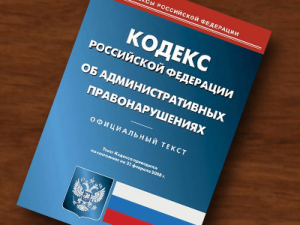 Article 12.16 of the Code of Administrative Offenses of the Russian Federation regulates the fine for violation of the requirements of signs and markings in 2017... It is in it that the amounts of fines are indicated for possible violations of the sign "No traffic".
Article 12.16 of the Code of Administrative Offenses of the Russian Federation regulates the fine for violation of the requirements of signs and markings in 2017... It is in it that the amounts of fines are indicated for possible violations of the sign "No traffic".
The first part is intended for light transport, and 6 and 7 for freight.
In accordance with the above article, the minimum fine for driving under the sign "No traffic" on a car or truck, is 500 rubles. In some cases, you can simply receive an official warning.
The relative ease of punishment is explained by the fact that traffic is prohibited on this section of the road and the driver cannot create obstacles in the movement of any vehicles.
But for such a violation in cities of federal significance, the amount of the fine may increase to 5,000 rubles, which will significantly hit the violator's pocket.
There is such a concept associated with the "No traffic" sign as "through passage" - it prohibits traffic along the entire section of the road.
In the event that the driver needs to enter without leaving the opposite side of the sign's coverage area, he will not be fined if he comes up with good reason and will be able to document it.
In 2016, amendments were made to the legislation, which make it possible to receive a discount on fines. This discount does not apply to all traffic fines, but Article 12.16 of the Administrative Code of the Russian Federation falls under these conditions.
This means that by violating the requirements of a sign prohibiting traffic, you can pay a fine with a 50% discount.
Compliance with payment deadlines is important. It is necessary that the fine be registered in the traffic police database, this is approximately three days from the date of the decision.
In addition, payment must be made no later than 20 days from the date of the order.
![]() Prohibitory sign 3.2 prohibits the movement of vehicles in certain cases... It applies to movement in both directions. Therefore, it is not installed on one-way roads.
Prohibitory sign 3.2 prohibits the movement of vehicles in certain cases... It applies to movement in both directions. Therefore, it is not installed on one-way roads.
The punishment for driving under the "No traffic" sign is not the most severe. This is a minimum fine of 500 rubles, and sometimes you can just earn a warning.
Like every sign, this one also has its own exceptions, according to which, its effect is canceled.
A vehicle driver who has the right to drive under a prohibition sign must have the relevant documents with him that prove this. Otherwise, the inspector may impose a fine.
"No traffic" - a prohibiting sign restricting the movement of vehicles on a specific section of the carriageway.
No traffic - 3.2
The installation of the pointer is provided on the section of the path where there is a ban on the movement of cars. The use of a noticeable emblem 3.2 in the places of side exits is provided together with the plates:
- 8.3.1;
- 8.3.2;
- 8.3.3.
Important ! The signs indicate the direction in which the prohibition is in effect.
Exceptions
There are a number of exceptions that apply to vehicles who have the right not to comply with the instructions specified in the traffic rules for the traffic sign is prohibited:
- cars serving enterprises located in the specified zone;
- cars belonging to citizens living in this territory;
- route taxis;
- vehicles transporting disabled people or driven by them;
- postal owned equipment, marked with a diagonal white stripe on a blue background.
Attention ! Entry and exit of citizens in these vehicles is carried out at the nearest intersection.

Attention ! Car owners living in the restricted area pass under the sign.
Traffic is prohibited for trucks
The rules provide for restrictions that apply exclusively to trucks. Sign 3.4 is installed, prohibiting the entry into a certain territory of certain categories of transport:
- heavy vehicles;
- tractors;
- self-propelled vehicles;
- trains with a mass exceeding 3.5 tons.
Attention ! The indicated tonnage is taken into account by default, since it is not written directly on the sign.
If it is necessary to indicate the tonnage of trucks for which traffic is prohibited, then a road sign 3.4 with a mark of 8 tons is installed. Transport with a mass exceeding this indicator is not allowed to enter the indicated territory, section of the road. There are certain exceptions that apply to the following vehicles:
- cars carrying people;
- post cars with special markings;
- transport without a trailer with a mass of up to 26 tons, serving enterprises in the specified area.
Attention ! Entry and exit is carried out at the nearest intersection.
Stop, then move
There are also a number of signs prohibiting movement in the chosen direction without first stopping:
- 3.17.1 - customs: a ban is imposed on passage through the checkpoint without a complete stop of the car;
- 3.17.2 - danger: the passage is not permissible, because an accident occurred, there was a fire or other disaster... There are no exceptions for the sign;
- 3.17.3 —control: prohibition of travel without suspension.
Identifying pointers, possibly by their external features, images on a white background and a red rim. A similar sign 3.1, completely prohibiting entry to all vehicles, with the exception of those traveling along the route. The sign has a red background on which a white rectangle is placed.
Attention ! Driving under this sign threatens to revoke your driver's license.
Inhibit group - no movement
The galaxy of prohibitive signs is supplemented by pointer 3.3, informing about the restriction of the movement of vehicles in all directions. The ban traditionally does not apply to minibuses, trolleybuses and trams, and besides them, cars driven by disabled people and cars of the postal service.
Motorcycle drivers should pay attention to the sign 3.5. Movement is prohibited for motorcycles, which does not allow the movement of two-wheeled vehicles, including those equipped with a trailer and having a total curb weight of 400 kg.
It is advisable for tractor owners not to lose sight of object 3.6, which prohibits the movement of this transport along certain sections of the path. The ban does not apply to self-propelled vehicles engaged in the maintenance of enterprises located in the territory limited by the sign.
There is an object 3.7 in the galaxy of prohibiting traffic signs, which does not allow the passage of trucks and tractors equipped with trailers and prohibits the towing of all types of transport.
The most common are signs that limit the passage of vehicles with a large mass. Sign 3.11 does not allow trucks with an actual total weight exceeding 7 tons. Sign 3.12 has a different meaning, limiting the load on one of the axles to 6 tons.
Excessive height exceeding 3.5 meters is controlled by sign 3.13, and the width of 2.7 m is regulated by road sign 3.14. The series of prohibitive symbols is completed by sign 3.15, which applies to mechanized road users with an overall length of 10 meters.
Special attention should be paid to 3.32 and 3.33, which control the sections of the path along which vehicles carrying dangerous goods and flammable substances.
Penalty for violation of the sign Movement prohibited
Violation of traffic regulations will result in the imposition of penalties in the amount of 500 rubles. The amount and procedure for collecting money is established in Art. 12.16 of the Administrative Code of the Russian Federation. A small penalty is caused by the inability of the offender to interfere with other participants and create an emergency situation, since according to the rules there should be no other transport in the specified area.
Mostly symbols 3.2 are installed on sections of the road with one-way traffic, in order to prevent the passage of oncoming cars. If an entry to such a site takes place, then the amount of the fine increases to 5,000 rubles. The traffic police inspector is guided by the circumstances and when they lead to the creation of a dangerous emergency, the punishment is reduced to deprivation of rights for up to 6 months.
Violation of the rules in the case of travel under 3.3, 3.4 is punishable by the collection of 500 rubles, and neglect of the 3.5 sign will lead to the legal collection of 300 rubles. Identical sanctions in the amount of 500 rubles are imposed in case of neglect of other objects of this group.
Legislative aspects governing the imposition of fines
The imposition of penalties is regulated by the Administrative Procedure Code, namely Article 12.16. The legislative act contains seven sections regulating traffic rules. The driver is advised to familiarize himself with all the provisions in order to know his rights and obligations:
- Failure to comply with the markings and signs is punishable by levying money in the amount of 500 rubles;
- performing a maneuver in violation of directions given by road signs - 1000 - 1500 rubles;
- moving towards the stream on a one-way carriageway - 5000 r, deprivation of rights for 4 - 6 months;
- repeated violation of the previous paragraph - a ban on driving for 1 year and a sanction in the amount of 5,000 rubles, if the fact of an offense is recorded by surveillance cameras;
- stopping and parking in the wrong place - 1500 rubles;
- parking or stopping at an unforeseen place in federal cities - Moscow, Sevastopol, St. Petersburg - 3000 rubles;
- the passage of trucks in restricted areas - 500 rubles;
- violation according to plate 3.4 in federal cities - Moscow, St. Petersburg, Sevastopol: 5000 rubles.
Application features and patterns
The action of the objects extends to the entire section of the path following the installed sign, up to the signs canceling them or the next intersection. There are a number of patterns by which it is possible to classify the considered symbols:
- identical appearance- products have a white background and a red rim, with an image in the center of the main information indicating the subject of the ban;
- have a number of exceptions - the ban does not apply to mechanized facilities that service enterprises in the exclusion zone and belong to citizens living in the specified area;
- comparable penalties regulated by the Code of Administrative Offenses.
Drivers for violation of the rules are not threatened with serious punishment, since there are practically no situations that provoke the occurrence of dangerous road accidents. 3.2 is considered an exception, as it is often installed in places with one-way traffic. If an exit is made to the carriageway against the main stream, then the rates increase sharply, the cost of error or malice increases for the driver 10 times.
It is required to carefully monitor the situation in the process of moving on a mechanized vehicle and timely identify the installed signs in order to avoid accidental passage. It is recommended to first study the route and the map of the location of the symbols in order to develop an alternative path. Carefully study the Administrative Procedure Code, which contains data on the amount of penalties for illegal actions of drivers.
If we talk in general about the signs prohibiting movement, then there are a lot of them. Namely, they are calculated from sign 3.1 to sign 3.17.2 in the traffic rules. Nevertheless, in this article we will analyze the penalty for violating the requirements of the second character in this list, for the character 3.2.
Before telling the reader about the fine for driving under the sign 3.2 "No traffic", let's decide how it looks. In fact, this is somewhat ironic, since the sign looks like an ordinary white circle, with a red border around the perimeter, that's all! Despite its name and a ban on movement, this sign is not so simple. After all, it does not always limit traffic for everyone, but only for a specific type of transport. So, for example, a sign can restrict passage for cargo vehicles (maximum mass over 3.5 tons), this is sign 3.4 or sign 3.7 for a vehicle with a trailer ...
So for whom and when does the sign restrict movement, and to whom does it permit? We will discuss all possible special cases associated with this sign in our article.
"Traffic is prohibited" or what is written about it in the traffic rules
First, about the sign itself. We have already mentioned how it looks like this - but did not provide an explanation for it. So in the traffic rules for the sign there is the following explanation.
In fact, such a short explanation can only introduce inaccuracies in the requirements of the mark, since there are explanations in the same section, only below.
Firstly, the sign restricts movement in both directions, that is, whether it is oncoming traffic or along the way.
Secondly, it does not apply to some vehicles, namely:
Route vehicles;
- TC of the federal postal service,
- vehicles that serve enterprises (say, garbage trucks) located in the designated area, and also serve citizens;
- personal vehicles living in the territory behind the sign or working in the designated area.
(In these cases, vehicles must enter and exit the designated area at the intersection closest to their destination)
- on vehicles driven by invalids of I and II groups or transporting such invalids;
Everything, nothing is said about the rest of the vehicles in the Rules.
So, with buses everything is clear, with disabled people too, but with vehicles living in the zone of the sign, as well as servicing enterprises in the zone of the sign, we will tell you in more detail. Do not think that by violating the action of this sign, you will tell the inspector that you live somewhere there, behind the sign. In this case, it is better to have supporting documents, be it a passport with a residence permit or a consignment note ( waybill) with the address of the recipient in the area of the mark or an indication that the vehicle has a need to pass the mark. Otherwise, the driver may well be fined. It is important to have not verbal arguments, but documents. Only then can you guarantee that everything will go as it should.
Where is the traffic prohibited sign usually installed?
Such a sign is usually installed at the entrance to a section of a road or territory where the movement of vehicles is prohibited. Before side exits to the road, the sign is used with one of the plates 8.3.1-8.3.3. This sign is not used for one-way roads. Usually sign 3.1 "No entry" is installed for roads with one-way traffic. For more details on the fine for violating this sign, see the article "Fines for travel under the" No entry "sign. The "No traffic" sign is usually installed at the entrance to courtyard areas ( living areas) an array of residential buildings.
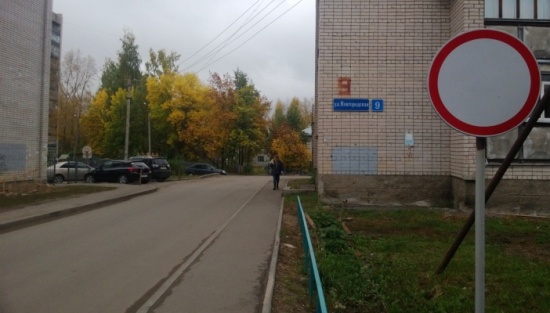
Also, the sign can be used with information plates 8.4.1-8.4.8, Let's say the movement is prohibited only for cargo vehicles.
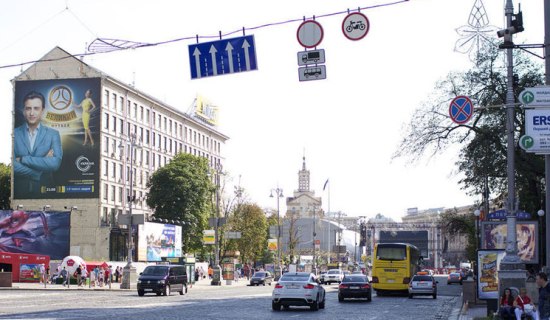
As you have noticed, the sign can be "common", that is, for all vehicles or for some specific type of vehicle. Let's say for motorcycles or tractors. Also, such a sign can be with an information plate. In this case, the information plate indicates the limitations of the sign in relation to certain vehicles. That is, the sign and the sign together with the plate are equivalent.
What article regulates the fine for travel under the sign "No traffic"
Everything is simple here. The lawmakers of order on the road have a "universal" article regulating the fine for violation of the requirements of signs and markings, namely article 12.16 of the Administrative Code of the Russian Federation. It is according to it, or more precisely, part 1 or 6.7, will be charged with violation of the sign "No traffic". In fact, part 1 is used for light vehicles, but parts 6.7 are for freight. Let us quote these parts.
|
1. Failure to comply with the requirements prescribed by road signs or markings of the carriageway, with the exception of cases provided for in parts 2-7 of this article and other articles of this chapter, - shall entail a warning or imposition administrative fine in the amount of 500 rubles. 6. Failure to comply with the requirements prescribed by road signs prohibiting the movement of freight vehicles, with the exception of the case provided for in part 7 of this article, - shall entail the imposition of an administrative fine in the amount of 500 rubles. 7. The violation provided for by part 6 of this article and committed in a city of federal significance Moscow or St. Petersburg - shall entail the imposition of an administrative fine in the amount of 5,000 rubles. |
Now we will directly summarize the information on fines.
Penalty for travel under the sign "No traffic" for cars and trucks
So, if you have not yet grasped the essence of the above, then let's say this! That if it is unauthorized to drive in a car or truck under the sign "No traffic", then in this case a minimum fine of 500 rubles will be issued. However, if such a violation occurs in cities of federal significance, and we have two such cities (Moscow, St. Petersburg), then according to part 7, article 12.16 of the Administrative Code of the Russian Federation, the fine can already be increased to 10 minimum, that is, up to 5,000 rubles. Not bad, isn't it !?
In this article, we still talked more about passenger transport, but a similar violation associated with by freight transport we have considered in the related article "Penalty for travel under the sign" The movement of freight vehicles is prohibited "".
Is it possible to pay a fine for the "No traffic" sign with a discount
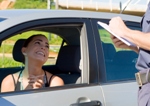 Since 2016, article 32.2 of the Code of Administrative Offenses of the Russian Federation has been amended to provide a "discount" on fines in accordance with Chapter 12 of the Code of Administrative Offenses of the Russian Federation. I must say that such a discount does not apply to all traffic police fines, however, Article 12.16 of the Administrative Offenses Code of the Russian Federation falls under these conditions. That is, a fine for violating the requirements of the "No traffic" sign can be paid with a 50 percent discount. The main thing here is to comply with the payment deadlines. First, it is important that the fine has already been registered in the traffic police database, this is about 3 days from the date of the decision. Second, payment must be made no later than 20 days from the date of the order.
Since 2016, article 32.2 of the Code of Administrative Offenses of the Russian Federation has been amended to provide a "discount" on fines in accordance with Chapter 12 of the Code of Administrative Offenses of the Russian Federation. I must say that such a discount does not apply to all traffic police fines, however, Article 12.16 of the Administrative Offenses Code of the Russian Federation falls under these conditions. That is, a fine for violating the requirements of the "No traffic" sign can be paid with a 50 percent discount. The main thing here is to comply with the payment deadlines. First, it is important that the fine has already been registered in the traffic police database, this is about 3 days from the date of the decision. Second, payment must be made no later than 20 days from the date of the order.
Question and answer on the topic "Penalty for travel under the traffic sign is prohibited"
Question: What is the fine for driving under the "No traffic" sign?
Answer: The minimum fine (500 rubles) for all vehicles and for cities in Russia. If it is Moscow or St. Petersburg and a cargo vehicle, then 5000 rubles.
Question: Does the amount of the fine for violation of the “No traffic” sign increase in case of a relapse. Repeated violation within 1 year?
Answer: No, it stays the same as the first time
The sign "No traffic" is a prohibiting sign and implies the prohibition of the passage of vehicles on a certain section of the road or delimited territory, except for certain categories of transport.
It should be noted that road sign 3.2 "No traffic" restricts traffic in any direction of traffic.
In this article:
Right of way under sign 3.2
- Vehicles with special signs such as postal services, police, ambulances and other specialized vehicles
- Special vehicles serving any objects located directly in the area of \ u200b \ u200bthe prohibiting sign, for example, special vehicles for housing and communal services, trucks supplying stores with goods, etc.
- Individual vehicles owned by citizens living or working in the territory of the traffic prohibited sign
- Vehicles following the route running through the territory of the sign 3.2 (buses, trams, trolleybuses, and other fixed-route taxis)
- Cars for disabled people of the first and second groups, drivers transporting disabled people, including disabled children
Place of installation of the prohibition sign 3.2
The law does not provide for specific criteria and zones for the installation of this road sign... From the Rules of the Road it follows only that the sign "No traffic" begins to operate directly from the place where it is located.
Drivers should be aware that along with sign 3.2, it is possible to install information plates and signs 8.3.1, 8.3.2, 8.3.3 indicating the direction and action of the prohibited zone, for example, at intersections. However, you need to be careful, because after turning it can simply not be noticed.
Penalty for travel under the traffic sign prohibited
This sign, although it has the character of a prohibition, is not too harsh in terms of punishment, therefore, it will not bring much harm to the family budget.
So in 2016 the punishment for driving under the sign "No traffic" is only 500 rubles, which in our time is considered not a very serious blow to the financial condition of the driver.
And besides, if an inspector suddenly stops you, it is possible to avoid receiving a receipt for payment of a fine, but simply receive a warning. It all depends on how you explain to the traffic police officer the reason for the violation of this traffic rule.
But if you are caught by this inspector for systematic ignoring the requirements of the traffic rules, then he, without hesitation, will write out a receipt and deprive you of your hard-earned 500 rubles.
Prohibitory sign 3.2
Finally, useful advice to motorists, in order to avoid the inspector's dishonest behavior and the imposition of administrative responsibility on you for a violation, you need to follow a few simple formalities.
Firstly, when meeting with a traffic police inspector, in order to have proof of your residence in the area where the traffic is prohibited sign, you need to have your passport with you.
Secondly, if you serve any object, for example, a store, show the inspector a waybill or waybill.
Thirdly, if you work in an organization that is located in the area of \ u200b \ u200bthe traffic sign "traffic is prohibited", carry with you a certificate from your place of work that you are an employee of this company.
In general, carry with you some kind of supporting document, proof that your movement in the area of \ u200b \ u200bthe given sign is not just a desire to shorten the bypass path or go around the ill-fated traffic jam.


